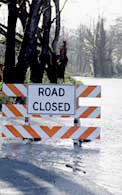Rain and Flooding

Rain causes wet pavement, which reduces vehicle traction and maneuverability. Heavy rain also reduces visibility distance. These impacts prompt drivers to travel at lower speeds causing reduced roadway capacity and increased delay. Speed reductions on arterial routes range from 10 to 25 percent on wet pavement. Light rain reduces freeway speed by 2 to 13 percent. Freeway speeds fall by 3 to 17 percent in heavy rain. Rain and wet pavement increase crash risk as well.
Most weather-related crashes occur on wet pavement and during rainfall. Each year, 75 percent of weather-related vehicle crashes occur on wet pavement and 47 percent happen during rainfall. Nearly 5,700 people are killed and more than 544,700 people are injured in crashes on wet pavement annually. Every year, over 3,400 people are killed and over 357,300 people are injured in crashes during rainfall.
Flooding reduces roadway capacity by limiting or preventing access to submerged lanes. Inland flooding, usually following the evolution of a tropical storm or hurricane, has typically been the greatest source of fatalities, and caused the most damage to roadway infrastructure.
Publications
To view publications related to rain and flooding, please select one of the following key words.
To view PDF files, you need the Adobe Acrobat Reader.


